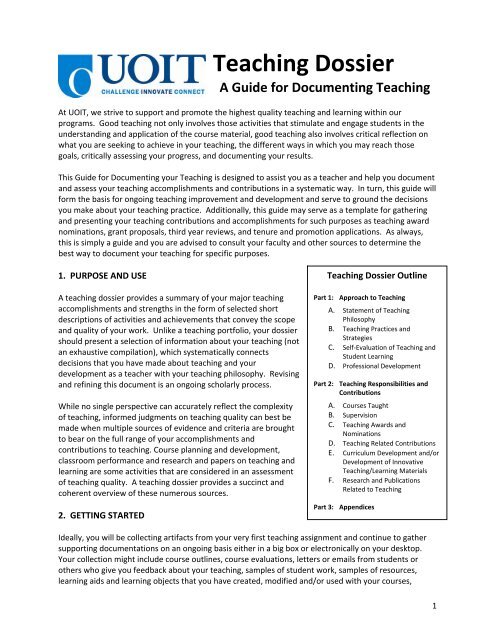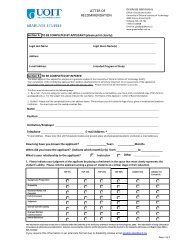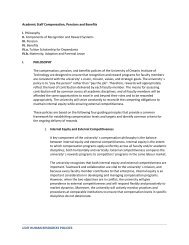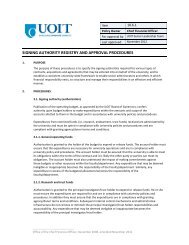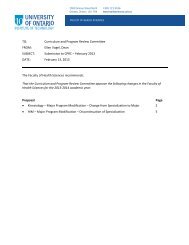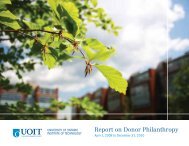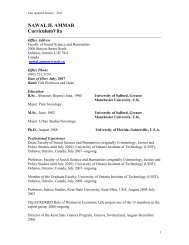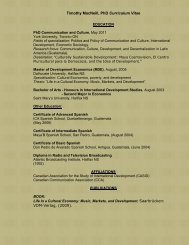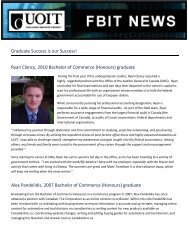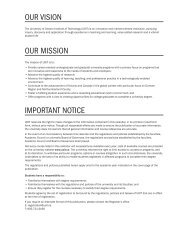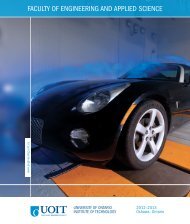Teaching Dossier
Teaching Dossier
Teaching Dossier
Create successful ePaper yourself
Turn your PDF publications into a flip-book with our unique Google optimized e-Paper software.
<strong>Teaching</strong> <strong>Dossier</strong><br />
A Guide for Documenting <strong>Teaching</strong><br />
At UOIT, we strive to support and promote the highest quality teaching and learning within our<br />
programs. Good teaching not only involves those activities that stimulate and engage students in the<br />
understanding and application of the course material, good teaching also involves critical reflection on<br />
what you are seeking to achieve in your teaching, the different ways in which you may reach those<br />
goals, critically assessing your progress, and documenting your results.<br />
This Guide for Documenting your <strong>Teaching</strong> is designed to assist you as a teacher and help you document<br />
and assess your teaching accomplishments and contributions in a systematic way. In turn, this guide will<br />
form the basis for ongoing teaching improvement and development and serve to ground the decisions<br />
you make about your teaching practice. Additionally, this guide may serve as a template for gathering<br />
and presenting your teaching contributions and accomplishments for such purposes as teaching award<br />
nominations, grant proposals, third year reviews, and tenure and promotion applications. As always,<br />
this is simply a guide and you are advised to consult your faculty and other sources to determine the<br />
best way to document your teaching for specific purposes.<br />
1. PURPOSE AND USE<br />
A teaching dossier provides a summary of your major teaching<br />
accomplishments and strengths in the form of selected short<br />
descriptions of activities and achievements that convey the scope<br />
and quality of your work. Unlike a teaching portfolio, your dossier<br />
should present a selection of information about your teaching (not<br />
an exhaustive compilation), which systematically connects<br />
decisions that you have made about teaching and your<br />
development as a teacher with your teaching philosophy. Revising<br />
and refining this document is an ongoing scholarly process.<br />
While no single perspective can accurately reflect the complexity<br />
of teaching, informed judgments on teaching quality can best be<br />
made when multiple sources of evidence and criteria are brought<br />
to bear on the full range of your accomplishments and<br />
contributions to teaching. Course planning and development,<br />
classroom performance and research and papers on teaching and<br />
learning are some activities that are considered in an assessment<br />
of teaching quality. A teaching dossier provides a succinct and<br />
coherent overview of these numerous sources.<br />
2. GETTING STARTED<br />
<strong>Teaching</strong> <strong>Dossier</strong> Outline<br />
Part 1: Approach to <strong>Teaching</strong><br />
A. Statement of <strong>Teaching</strong><br />
Philosophy<br />
B. <strong>Teaching</strong> Practices and<br />
Strategies<br />
C. Self‐Evaluation of <strong>Teaching</strong> and<br />
Student Learning<br />
D. Professional Development<br />
Part 2: <strong>Teaching</strong> Responsibilities and<br />
Contributions<br />
A. Courses Taught<br />
B. Supervision<br />
C. <strong>Teaching</strong> Awards and<br />
Nominations<br />
D. <strong>Teaching</strong> Related Contributions<br />
E. Curriculum Development and/or<br />
Development of Innovative<br />
<strong>Teaching</strong>/Learning Materials<br />
F. Research and Publications<br />
Related to <strong>Teaching</strong><br />
Part 3: Appendices<br />
Ideally, you will be collecting artifacts from your very first teaching assignment and continue to gather<br />
supporting documentations on an ongoing basis either in a big box or electronically on your desktop.<br />
Your collection might include course outlines, course evaluations, letters or emails from students or<br />
others who give you feedback about your teaching, samples of student work, samples of resources,<br />
learning aids and learning objects that you have created, modified and/or used with your courses,<br />
1
course notes, etc. You will want to gather evidence of your activities and professional development so<br />
that when you are ready to create your dossier, you have a broad range of materials in your collection<br />
which will inform and support your teaching dossier.<br />
3. COMPONENTS OF A TEACHING DOSSIER<br />
Part 1: Approach to <strong>Teaching</strong> (approximately 4 pages)<br />
The items in this section provide a basis for judgments on the information presented in the remaining<br />
sections and enable you to direct attention to the areas that you see as most important to your teaching<br />
practice.<br />
A. Statement of <strong>Teaching</strong> Philosophy (approximately 1/2 page)<br />
A statement of teaching philosophy is a personal statement that sets out the central components of<br />
what you are trying to achieve in your teaching and in the learning goals you have for your students<br />
in the context of your discipline. Your teaching statement serves as a thesis statement supported by<br />
the subsequent sections of your dossier with evidence of specific practices and strategies you use in<br />
your courses, the scope of your responsibility and contributions and your success in achieving your<br />
teaching and learning goals.<br />
Listed below are a few questions that you might find helpful in developing your teaching philosophy.<br />
• What are your learning goals for your students For yourself Why<br />
• How are these goals reflected in your courses<br />
• How would you describe the ideal learning environment<br />
• How do you conceptualize learning <strong>Teaching</strong><br />
• How do you embed learning technology into your courses<br />
• How do you engage students in your subject/field and make your teaching inclusive<br />
B. <strong>Teaching</strong> Strategies (approximately 1‐2 pages)<br />
This section provides evidence on how you bring your teaching philosophy to life, identifying the key<br />
strategies and methodologies that you have integrated into your courses, including the use of<br />
learning technologies. For each of these key strategies, provide a brief description and explain how<br />
it advances your teaching goals. You might include such aspects as how you structure your course;<br />
how you make decisions about course content, resources, technology integration and assignments;<br />
how you respond to different learning needs; how you assess students; and how you integrate<br />
students’ feedback and encourage participation.<br />
C. Self‐Evaluation of <strong>Teaching</strong> and Student Learning (approximately 1‐2 pages)<br />
This section measures the success of your teaching strategies (section B) in light of your teaching<br />
philosophy (section A), and provides an analysis of the evidence that documents your success in<br />
fostering and supporting students’ learning. To document your success, you should collect and<br />
synthesize information from a variety of sources such as individual student achievements, learning<br />
outcomes, class outcomes and course evaluations. The results of any classroom research you have<br />
undertaken can be used to demonstrate your students’ learning and achievements. In addition, you<br />
should outline steps you have taken to adjust your teaching as a result of your self‐evaluation and<br />
students’ feedback and how it relates to your teaching strengths and areas for attention.<br />
Provide samples of indicators for this analysis, such as:<br />
2
• Overview of course evaluation results (summarize the information in your course<br />
evaluations in a succinct and informative way, for example, on a graph or table, plot key<br />
questions relating to your teaching goals and strategies to show how they have developed<br />
over time, include response rates, comparative data, and rating scale if appropriate)<br />
Note: High or low ratings in a single course or year do not provide conclusive evidence of<br />
exceptional or unacceptable teaching. In addition, results with low response rates have not<br />
been found to be valid predictors of effective performance.<br />
• Selected student comments<br />
• Summary of classroom research (e.g., one‐minute papers, informal surveys, mid‐year<br />
feedback, etc.)<br />
• Other indicators of student achievement (e.g., professional competitions, graduate<br />
placements, best paper awards, etc.)<br />
D. Professional Development of <strong>Teaching</strong>/Learning (approximately 1/2 page)<br />
This section answers the question: how do you keep up with new developments in university<br />
teaching It demonstrates your commitment to ongoing growth and improvement as a teacher<br />
through the acquisition of new knowledge, the examination of new approaches to teaching and<br />
learning, and participation in dialogue about teaching and learning (e.g., teaching development<br />
sessions, conferences, professional networks in which you have participated).<br />
Part 2: <strong>Teaching</strong> Responsibilities and Contributions (approximately 4 pages)<br />
The information in this section reflects your roles and responsibilities in your faculty and program,<br />
substantiates your professionalism as a teacher, highlights recognition received, demonstrates your<br />
leadership in this area, and identifies activities that have contributed to the strengthening the culture of<br />
teaching at UOIT more generally. Items in this section combine with the previous section to provide a<br />
context to inform subsequent judgments about the quality of your teaching.<br />
Many of these items will be listed in the teaching section of your curriculum vitae; however, you may<br />
wish to elaborate on specific items within the dossier to situate your contributions more fully.<br />
Subsections can include all or some of the following:<br />
A. Courses Taught<br />
• Include enrolment information, level of responsibility, co‐teaching, supervision of TAs, etc.<br />
Provide a context for the courses, e.g., complexity of course content, course format, student<br />
demographics, special challenges, and whether they are mandatory or elective courses<br />
• Detail other teaching activities, such as supervision of a teaching or research practicum,<br />
capstone projects, lab or thesis course component, coaching, field placement supervision,<br />
mentoring, etc.<br />
B. Supervision<br />
• Describe the nature and extent of your role as supervisor for advanced students preparing<br />
theses or dissertations, indicating your responsibilities and the level of study (whether doctoral,<br />
masters or undergraduate level)<br />
• Indicate outcomes of your supervision e.g., theses title and acceptance date, citations of student<br />
publications, dates and venues of public presentations<br />
3
C. <strong>Teaching</strong> Awards and Nominations<br />
• List external and internal teaching awards, including date, sponsoring unit or organization, and<br />
how initiated (e.g., by students, peers, unit, etc.)<br />
D. <strong>Teaching</strong> Related Contributions<br />
Items may include:<br />
• Mentoring TAs and/or colleagues on course development or teaching improvement,<br />
professional exchanges with colleagues inside or outside UOIT on, for example, course materials<br />
or teaching methods, etc.<br />
• Instances where you played a leadership role or were recognized for your teaching ability (e.g.,<br />
presentations on teaching, requests to demonstrate your teaching, workshop facilitation, etc.)<br />
• Committee membership and the nature of your contribution (e.g., describe how you have made<br />
a difference to the committee and its work)<br />
E. Curriculum Development and/or Development of Innovative <strong>Teaching</strong>/Learning Materials<br />
Items may include:<br />
• Revisions to or development of new courses and programs, individually or in collaboration with<br />
colleagues to align courses with program goals<br />
• Integration of new technology in own courses and/or support to others, promoting such<br />
approaches by others in your year, program or faculty<br />
• Development of curriculum materials and other teaching resources that have been<br />
acknowledged by others or have subsequently been used elsewhere, such as published or<br />
unpublished curriculum materials, textbooks, workbooks, case studies, lab manuals, etc.<br />
• Development of learning technologies and their use in your course and other courses<br />
F. Research and Publications Related to <strong>Teaching</strong><br />
Items may include:<br />
• Research, conference presentations, articles, etc. appearing in general or discipline‐specific<br />
publications on teaching<br />
• Grant and course releases for teaching projects<br />
Part 3: Appendices:<br />
• Multiple course summary<br />
• Course evaluation reports from UOIT and elsewhere, if appropriate<br />
• Samples of other evaluations completed by students, if appropriate<br />
• Examples of student achievement<br />
• Other materials if referenced in dossier<br />
‐‐‐‐‐‐‐‐‐‐‐‐‐‐‐‐‐‐‐‐‐‐‐‐‐‐‐‐‐‐‐‐‐‐‐‐‐‐‐‐‐‐‐‐‐‐‐‐‐‐‐‐<br />
For further information and assistance on developing your teaching dossier, please contact the Office of<br />
the Associate Provost, <strong>Teaching</strong> and Learning (UB 2014, ext. 2786).<br />
April 2009<br />
4


